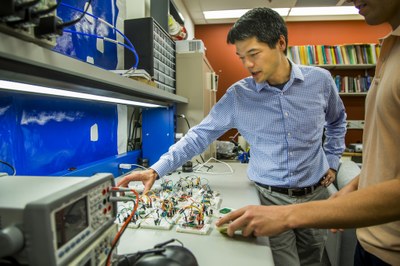By Jon Gabay, contributing writer
It seems that the more advanced we and our devices become, the more susceptible we are to wrong-doers. From the time of the first spear and club to help us hunt and gather, they were also able to be used as weapons against us. Every advance that can be a boon can also be a detriment. Perhaps this is just an unavoidable and unfortunate fact of human nature.
For those who love to live in the world of doom and gloom and paranoia, another recent discovery is making it even easier to feel unsafe and insecure. Researchers have found a way to use sound as a means of hacking into electronic systems that use accelerometers. Sonic waves and interference patterns can fool inertial-based sensors and overwhelm them into producing false readings that can interfere with normal operations.

Researchers at Michigan University used precisely tuned acoustic tones to deceive 15 different models of accelerometers. Image source: Michigan University.
Researchers at Michigan University have demonstrated that MEMs-based accelerometers can be fooled by sound and pass along false information to non-fault-tolerant software that autonomously controls operations. These can be things as simple as dead-reckoning inertial navigation systems in cars (especially emerging self-driving vehicles), as well as medical devices that can use embedded accelerometers to monitor and control flows of drugs and medications.
While toys and step monitors for health are simple targets, they pose no real threats to society. Even smartphones can only be fooled by apps that use the accelerometers. But air vehicles, especially drones and robots, can be fooled into navigating incorrectly and even be used as weapons, and this is where the threat can become frightening.
So what can be done to circumvent these potentially malicious and dangerous uses of our technologies? Both software and hardware approaches can be utilized, as well as material sciences. Hardware- and software-based filtration can detect binaural patterns that can fool sensors and either reject information or go into a fallback mode similar to the ‘limp home’ modes programmed into most automotive computers.
Another technique is to use sound-deadening materials to surround the accelerometers. Because accelerometers work by changes in inertia in a specific axis, the elimination of sound should not affect the readings that inertial changes would produce.
Personally, though, I would not worry about smart phones and navigational systems. Because these use satellite-based global positioning systems and cellular-based geolocation, these signals will not be affected by any sonic interference. But according to researchers at Michigan, they claim to have the ability to spell out words and send commands on a smartphone using this technique.
I don’t see how this can occur, unless a coexisting app was installed that used the accelerometer as a sort of modem back door. This is not impossible, especially today, when apps have permissions (or not) to take control of aspects of a smartphone for good or nefarious purposes.
The bottom line is that there is no privacy, nothing is secure, and all of the devices that we use and count on can turn against us. Sounds like a B-rated science fiction movie, doesn’t it? Maybe they should change the rating system.
What are your thoughts? Leave a comment below.
Advertisement
Learn more about Electronic Products Magazine





